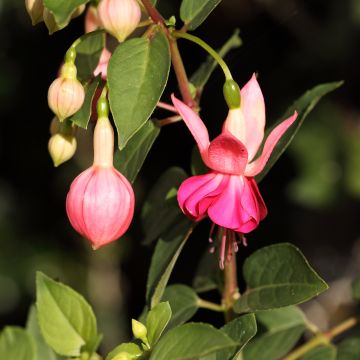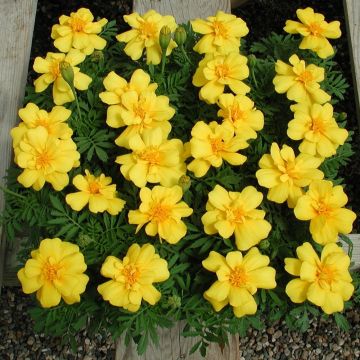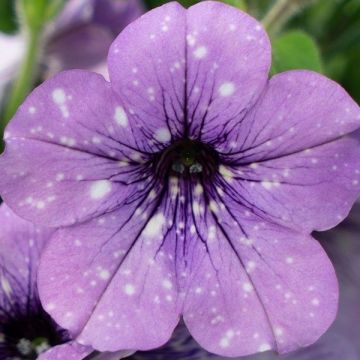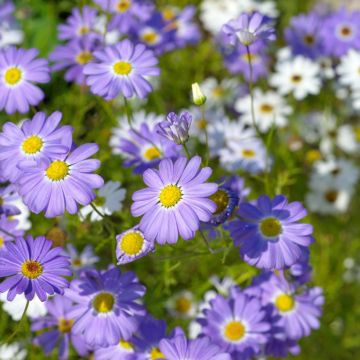

Fuchsia retombant Dark Eyes


Fuchsia retombant Dark Eyes
Fuchsia Dark Eyes
Fuchsia x hybrida Dark Eyes
Hybrid Fuchsia
She didn't last 1 month
DEDE, 23/12/2024
This item cannot be shipped to the selected country
Delivery charge from €5.90
More information
Schedule delivery date,
and select date in basket
This plant carries a 6 months recovery warranty
More information
We guarantee the quality of our plants for a full growing cycle, and will replace at our expense any plant that fails to recover under normal climatic and planting conditions.
From €5.90 for pickup delivery and €6.90 for home delivery
Express home delivery from €8.90.
Does this plant fit my garden?
Set up your Plantfit profile →
Description
Fuchsia 'Dark Eyes' is a particularly elegant trailing variety. From late spring until the end of summer, it is adorned with voluptuous bicoloured flowers, featuring a red tube and sepals that crown a double and frilly corolla of deep blue-violet. This impressive variety is perfect for hanging baskets. It is easy to grow in partial shade, in fertile, moist and light soil.
There are thousands of hybrid fuchsias. For the most part, they are derived from Fuchsia magellanica and F. fulgens, with occasional contributions from F. triphylla, which adds length to the flowers, characterised by thin tubes and violet-hued undersides of the leaves. All these herbaceous to woody plants, varying in hardiness and growth habit, belong to the Onagraceae family.
Fuchsia 'Dark Eyes' quickly forms a generous, spreading and trailing bush, 40 to 50cm (16 to 20in) tall when in flower, with a similar width. Its flowering period extends from June to September-October. It stands out with its magnificent double flowers, whose weight gracefully bends the stems, transforming the plant into a flowering cascade. They consist of a tube extended by 4 long, upturned, bright red sepals, and a crown of wider and shorter double petals in a blue-purple-violet shade, embedded in the outer corolla of sepals. Short red stamens complete the colour harmony. The stems are initially herbaceous, becoming somewhat woody as the season progresses. They bear an abundance of foliage composed of slender deciduous leaves. They are opposite, whorled in groups of 3 or 5, with entire, dentate margins, measuring 5 to 8cm (2 to 3in) in length. The lanceolate leaves are a glossy dark green. Its hardiness does not exceed -5°C (23°F) in open ground.
Usually grown as an annual, this fuchsia is a perennial that can be grown in a large pot that can be brought indoors for the winter to protect it from frost. It can also be grown in open ground for one season, or even longer in mild climates. Fuchsias go well with the foliage of ferns, rodgersias, orange-coloured heucheras, or light green hostas. In a flower pot, they can be planted with ivy, Dichondra 'Silver Falls', lobelias, or bacopas with very delicate flowers. Large double-flowered varieties will be enhanced by upright varieties such as F. 'Price Noir' or F. 'Winston Churchill'.
Discovered in Santo Domingo in the 17th century and acclimatised in Europe, it was named Fuchsia (not Fuschia) in honour of a German botanist named Fuchs. Native to South America, botanical fuchsias have gradually multiplied. There are now believed to be tens of thousands of hybrids!
They are supplied as green plants measuring 4 to 8cm (2 to 3in) in cases of 5 small plugs with a diameter of 2.8cm (1in) and a height of 4cm (2in). Our plants are at least eight weeks old and strong enough to be planted in open ground.
Report an error about the product description
Fuchsia Dark Eyes in pictures




Flowering
Foliage
Plant habit
Botanical data
Fuchsia
x hybrida
Dark Eyes
Onagraceae
Hybrid Fuchsia
Cultivar or hybrid
Other Fuchsia
Planting and care
Plant your fuchsias in rich, moist, and well-drained substrate, in full sun or partial shade. Fuchsias need plenty of light to flower well, but they are sensitive to direct sunlight in the summer. Water regularly, as they are sensitive to drought. However, avoid overwatering. When grown in pots, do not leave water in the saucer, as it can cause the roots to rot and the leaves to fall off. Feed with a liquid fertiliser for fuchsias every 15 days during the growth period. Regularly remove faded flowers and dry leaves. Young shoots can be pinched to encourage the plant to branch out and produce more flowers, which are always borne on the current year's shoots. Prune back in autumn after flowering. Fuchsias can also be grown indoors, where they are perennial and evergreen.
Planting period
Intended location
Care
-
, onOrder confirmed
Reply from on Promesse de fleurs
Plug plants - Annuals
Haven't found what you were looking for?
Hardiness is the lowest winter temperature a plant can endure without suffering serious damage or even dying. However, hardiness is affected by location (a sheltered area, such as a patio), protection (winter cover) and soil type (hardiness is improved by well-drained soil).

Photo Sharing Terms & Conditions
In order to encourage gardeners to interact and share their experiences, Promesse de fleurs offers various media enabling content to be uploaded onto its Site - in particular via the ‘Photo sharing’ module.
The User agrees to refrain from:
- Posting any content that is illegal, prejudicial, insulting, racist, inciteful to hatred, revisionist, contrary to public decency, that infringes on privacy or on the privacy rights of third parties, in particular the publicity rights of persons and goods, intellectual property rights, or the right to privacy.
- Submitting content on behalf of a third party;
- Impersonate the identity of a third party and/or publish any personal information about a third party;
In general, the User undertakes to refrain from any unethical behaviour.
All Content (in particular text, comments, files, images, photos, videos, creative works, etc.), which may be subject to property or intellectual property rights, image or other private rights, shall remain the property of the User, subject to the limited rights granted by the terms of the licence granted by Promesse de fleurs as stated below. Users are at liberty to publish or not to publish such Content on the Site, notably via the ‘Photo Sharing’ facility, and accept that this Content shall be made public and freely accessible, notably on the Internet.
Users further acknowledge, undertake to have ,and guarantee that they hold all necessary rights and permissions to publish such material on the Site, in particular with regard to the legislation in force pertaining to any privacy, property, intellectual property, image, or contractual rights, or rights of any other nature. By publishing such Content on the Site, Users acknowledge accepting full liability as publishers of the Content within the meaning of the law, and grant Promesse de fleurs, free of charge, an inclusive, worldwide licence for the said Content for the entire duration of its publication, including all reproduction, representation, up/downloading, displaying, performing, transmission, and storage rights.
Users also grant permission for their name to be linked to the Content and accept that this link may not always be made available.
By engaging in posting material, Users consent to their Content becoming automatically accessible on the Internet, in particular on other sites and/or blogs and/or web pages of the Promesse de fleurs site, including in particular social pages and the Promesse de fleurs catalogue.
Users may secure the removal of entrusted content free of charge by issuing a simple request via our contact form.
The flowering period indicated on our website applies to countries and regions located in USDA zone 8 (France, the United Kingdom, Ireland, the Netherlands, etc.)
It will vary according to where you live:
- In zones 9 to 10 (Italy, Spain, Greece, etc.), flowering will occur about 2 to 4 weeks earlier.
- In zones 6 to 7 (Germany, Poland, Slovenia, and lower mountainous regions), flowering will be delayed by 2 to 3 weeks.
- In zone 5 (Central Europe, Scandinavia), blooming will be delayed by 3 to 5 weeks.
In temperate climates, pruning of spring-flowering shrubs (forsythia, spireas, etc.) should be done just after flowering.
Pruning of summer-flowering shrubs (Indian Lilac, Perovskia, etc.) can be done in winter or spring.
In cold regions as well as with frost-sensitive plants, avoid pruning too early when severe frosts may still occur.
The planting period indicated on our website applies to countries and regions located in USDA zone 8 (France, United Kingdom, Ireland, Netherlands).
It will vary according to where you live:
- In Mediterranean zones (Marseille, Madrid, Milan, etc.), autumn and winter are the best planting periods.
- In continental zones (Strasbourg, Munich, Vienna, etc.), delay planting by 2 to 3 weeks in spring and bring it forward by 2 to 4 weeks in autumn.
- In mountainous regions (the Alps, Pyrenees, Carpathians, etc.), it is best to plant in late spring (May-June) or late summer (August-September).
The harvesting period indicated on our website applies to countries and regions in USDA zone 8 (France, England, Ireland, the Netherlands).
In colder areas (Scandinavia, Poland, Austria...) fruit and vegetable harvests are likely to be delayed by 3-4 weeks.
In warmer areas (Italy, Spain, Greece, etc.), harvesting will probably take place earlier, depending on weather conditions.
The sowing periods indicated on our website apply to countries and regions within USDA Zone 8 (France, UK, Ireland, Netherlands).
In colder areas (Scandinavia, Poland, Austria...), delay any outdoor sowing by 3-4 weeks, or sow under glass.
In warmer climes (Italy, Spain, Greece, etc.), bring outdoor sowing forward by a few weeks.






















































